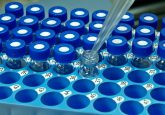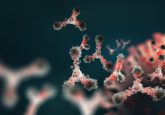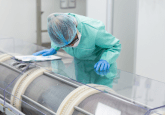Development of a fast method for direct analysis of intact synthetic insulins in human plasma: the large peptide challenge

Background: Intact insulins are difficult to analyze by LC-MS/MS due to nonspecific binding and poor sensitivity, solubility and fragmentation. This work aims to provide a simpler, faster LC-MS method and focuses on solving the above issues. Results: A novel charged-surface chromatographic column produced peak widths for insulin that were significantly narrower than traditional C18 columns when using formic acid as mobile phase. Mass spectral fragments m/z >700 provided greater specificity, significantly reducing endogenous background. Detection limits in human plasma were 0.2 ng/ml for insulin glargine, glulisine and detemir, and 0.5 ng/ml for insulin aspart. Average accuracy for standard curve and QC samples was 93.4%. Conclusions: A simple SPE LC-MS analysis was developed for direct, simultaneous quantification of insulin glargine, detemir, aspart and glulisine.
Of these biopharmaceuticals, insulin is one of the oldest and, perhaps, best known, and to this day remains the primary treatment for diabetes. In addition to recombinant human insulin, a number of closely related analogs with altered PK have been developed, resulting in several long-, fast- and intermediate-acting versions. Insulin glargine and insulin detemir are two popular long-acting analogs, effectively stabilizing blood glucose for 24 and 16 h, respectively [1]. Glargine is homologous to insulin except for the substitution of glycine for asparagine at position 21 of the A-chain and the addition of two arginines to the C-terminus of the B-chain (Figure 1). These changes shift the isoelectric point (pI) from 5.4 (pI of endogenous insulin) to approximately 6.7. This results in reduced solubility at physiological pH, which causes formation of a microprecipitate when the acidic solution is injected. It is the slow release of the drug from this precipitate that elongates the half-life of glargine. It is believed that these sequence changes also increase the natural propensity of insulin to form hexamers, which further prolongs bioavailability.
Click here for the full article.





